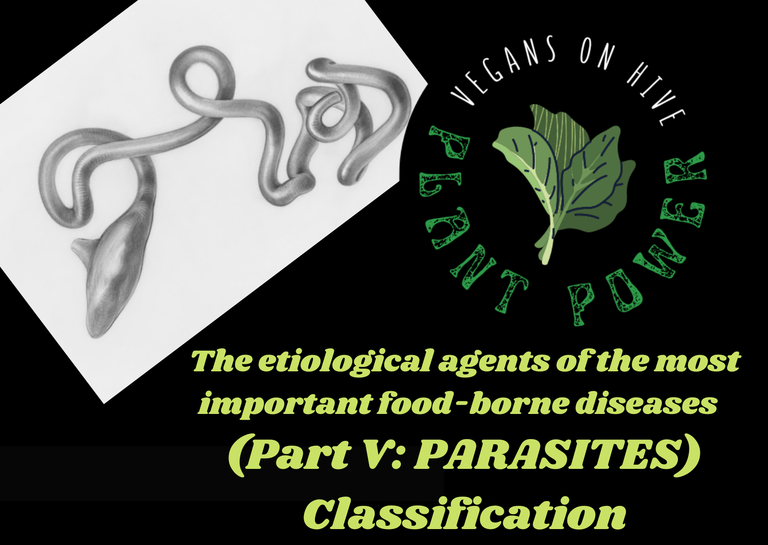
Hello plant based foodies, wherever you are in the world and the galaxy! Here @sirenahippie
The etiological agents of the most important food-borne diseases (Part I: BACTERIA)
The etiological agents of the most important food-borne diseases (Part II: VIRUSES)
The etiological agents of the most important food-borne diseases (Part III: VIRUSES)


Parasites. Classification and modes of transmission

Protozoa
These parasites have a particular life cycle, as they enter the host as cysts, and then transform into trophozoites in the small intestine, capable of absorbing nutrients directly from the host. They then enter the reproductive cycle, to become cysts again, which are expelled to the exterior in the feces, and can contaminate water and food. The protozoa are the following:
- Crypstosporidium parvum
- Crypstosporidium hominis
- Cyclospora cayetanensis
- Dientamoeba fragilis
- Entamoeba histolytica
- Giardia lamblia
- Balantidium col
Transmission is via oral-fecal route, through the ingestion of water and food contaminated by protozoan cysts. These parasites are zoonotic, since some of them can inhabit reservoir animals, and can cross the interspecies barrier.

Helminths
Helminths, as previously indicated, are multicellular, and their most common form is as worms. They are divided into three large groups, namely: Nematodes, Trematodes, and Cestodes. They also are zoonotic.

Nematodes parasitize all animals, causing many diseases. They are very thin worms, and there are more than 25 thousand registered species.
- Enterobius vermicularis: Transmission via oral-fecal route
- Trichiura trichuris: Transmission via oral-fecal route
- Ascaris lumbricoides: Transmission via oral-fecal route
- Ancylostoma duodenale: Transmission via skin-oral route
- Necator americanus: Transmission via skin
- Toxocariasis cani: Transmission via oral route
- Toxocara cati: Transmission via oral route
- Strongiloides stercolaris: Transmission via skin route
- Anisakiasis simplex: Transmission via oral route

Trematodes are parasites in the form of worms, generally flattened, with hooks and suckers to adhere to their host. Their life cycle is more complex than that of other helminths. They can affect organs such as lungs, liver, muscles, etc.
- Fasciola hepatica: Transmission via oral route
- Paragonimus wetermani: Transmission via oral route
- Schistosoma haematobium: Transmission via skin
- Schistosoma japonicum: Transmission via skin
- Schistosoma mansoni: Transmission via skin
However, apart from these modes of transmission, it is presumed that there is a link between these parasites and the ingestion of raw or undercooked freshwater fish and crustaceans; also through the ingestion of algae, watercress, lamb's lettuce and other aquatic plants that are contaminated.

Cestodes are tape-shaped worms. Their structure is very particular, because they lack a digestive system, but they can cause serious diseases, such as Cysticercosis. They can reach a length of 15 meters!!!!
- Taenia saginata
- Taenia solium
- Diphyllobothrium latum
- Hymenolepis nana
- Echinococcus granulosus
- Echinococcus multilocularis
All cestodes or tapeworms are transmitted orally, but apart from this mode of transmission, it is presumed that there is a link between these parasites and the ingestion of raw or undercooked beef and pork.

BIBLIOGRAPHY


You've been curated by @plantpoweronhive! Delegations welcome!
Posted Using InLeo Alpha
